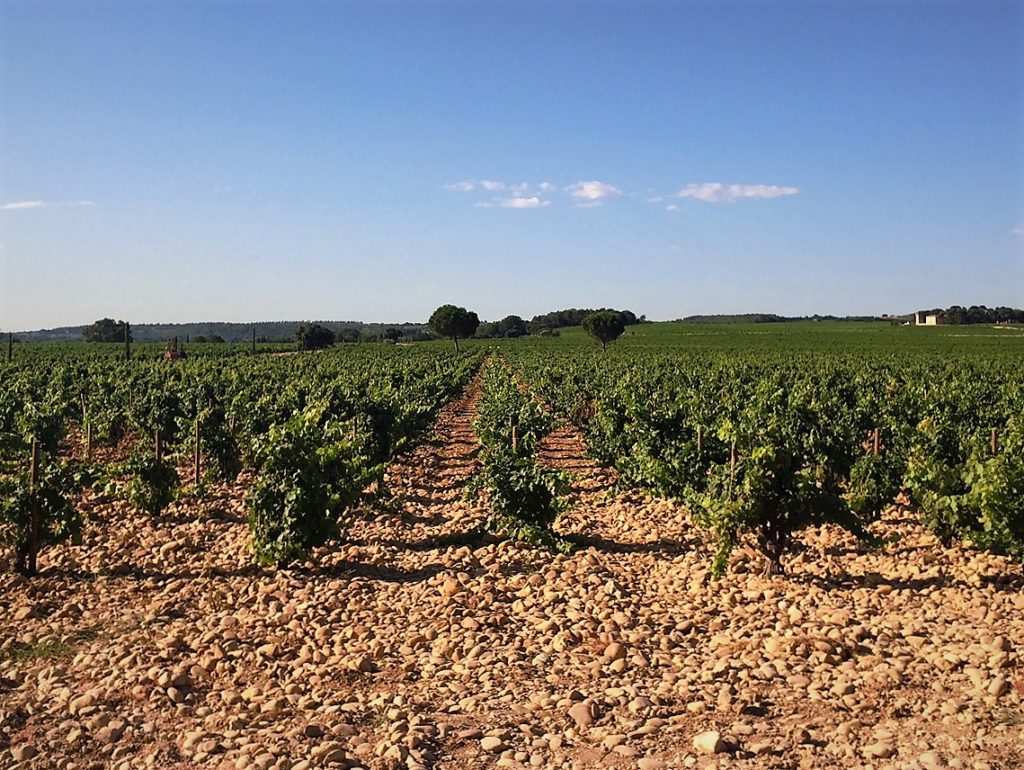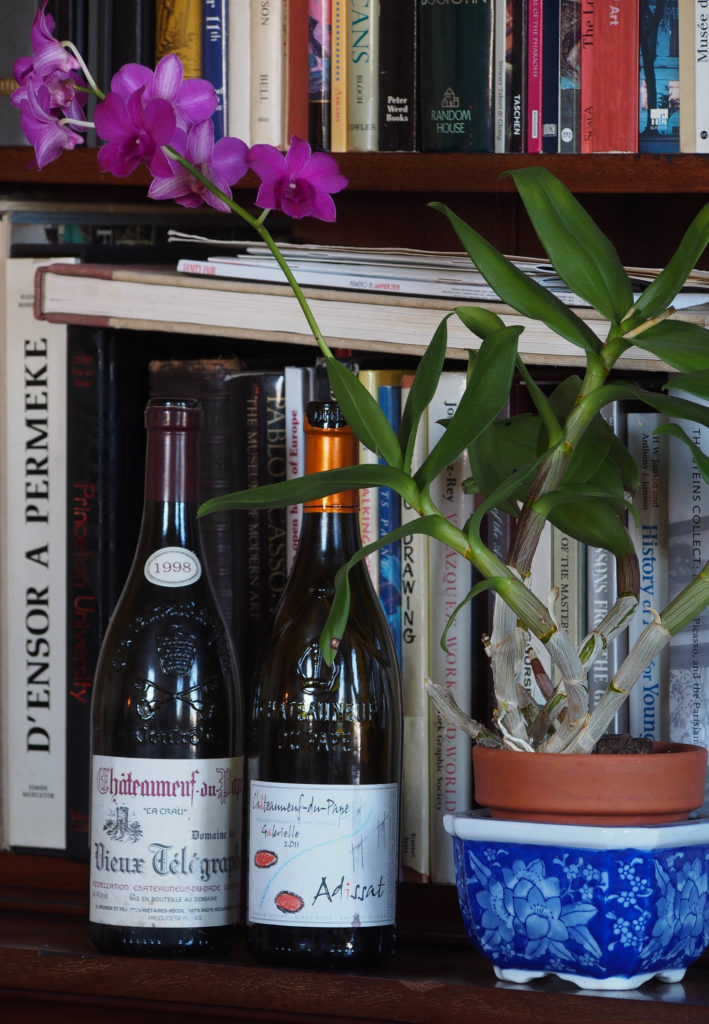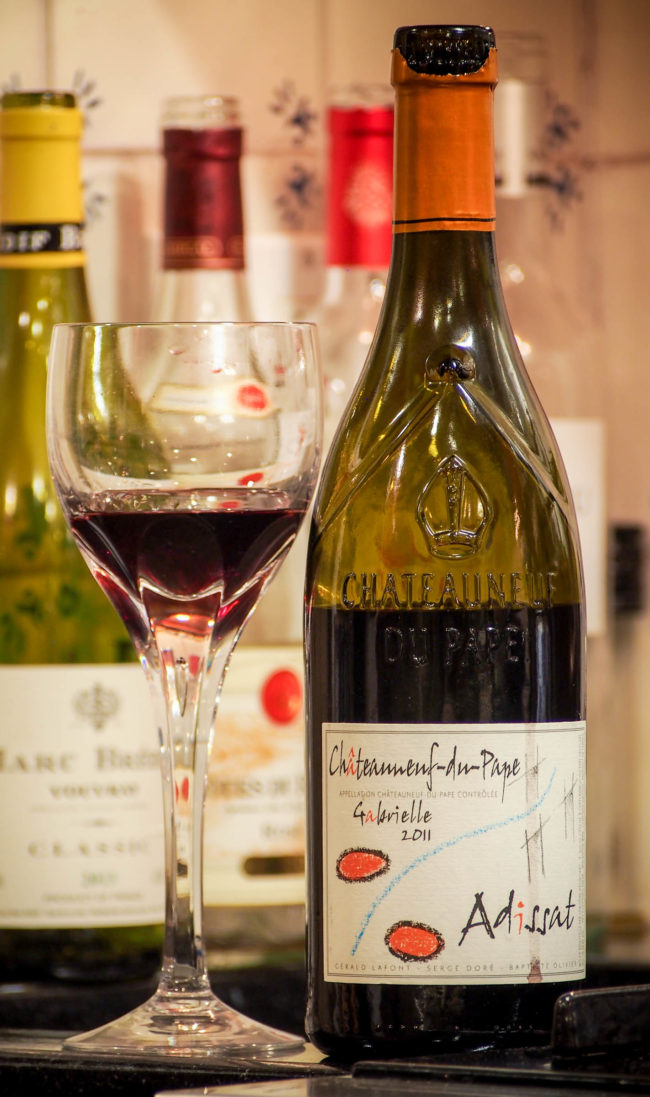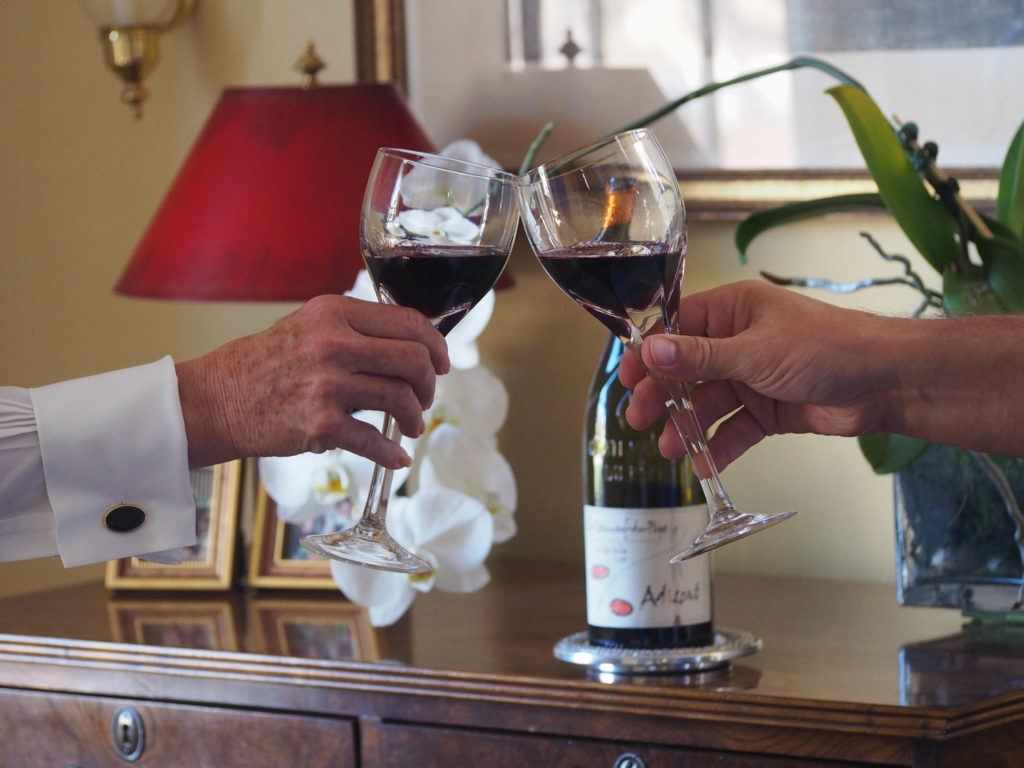A CHÂTEAUNEUF-DU-PAPE IN HONOR OF POPE FRANCIS
by Susan Manfull
Since the arrival of Pope Francis in Washington, D.C. and his stirring address to Congress—rousing all but the most lackluster members of this elite audience—I have been riveted by his words to each of the disparate groups he would go on to meet. No matter what one’s political or religious beliefs may be, there seemed to be something for everyone. It was the universality of his message and the words he chose to convey it that moved me. The Pope spoke to our most basic sense of humanity and urged what’s best in each of us to come forth to make the world a better place and indeed to make better the world itself.
At the risk of appearing irreverent, I am going to do what any dedicated wine writer would do and open a bottle of Châteauneuf-du-Pape in honor of Pope Francis. Fortunately for my pocketbook, I don’t think the Pope’s profound selflessness would appreciate me draining my wine research funds—in his name—on a Château de Beaucastel (over $100), regardless of how heavenly it may be. I opted for a more moderately priced ($40) Châteauneuf-du-Pape from a relatively new producer, Adissat. The 2011 cuvée is called Gabrielle. It’s in the dining room, breathing, waiting for me to finish this post.
Châteauneuf-du-Pape, literally means “Pope’s new castle.” It was the summer residence of the popes when, from 1309 to 1377, the Papal Palace was located in Avignon, along the Rhône River. During this period, the popes lived and conducted the business of the church out of this location in Provence—not Italy.
Vines had covered the ground around the village that came to be called Châteauneuf since Roman times and the good wine they produced was certainly no secret before the popes arrived, but it was the popes with their discriminating palates who made the wines so famous in the last part of the Middle Ages.
Although Pope Clement V, the first of seven popes to serve the Avignon Papacy, is credited with recognizing the viticulture possibilities of this area, it is his successor, Pope John XXII, who chose this elevated area, midway between Avignon and Orange, to be the summer residence of the papacy. As a former bishop of Avignon, he also would have known about the high quality of the local wines, which surely influenced his choice of location for the place of refuge that came to be known as Châteauneuf-du-Pape. It was close enough to Avignon to conduct business but far enough to discourage uninvited visitors. Work commenced on a fortified residence in 1317 (including, mais oui, the planting of more grapevines and olive trees) and was completed in 1333, just before his reign ended.
In 1334, records show that there were as many as 800 hectares (1977 acres) of vines in Châteauneuf. Wine quenched the thirst of those in the Papacy as well as many foreign dignitaries who came to visit. Barrels of this wine would soon find their way to other countries such as Italy, Germany, and England.

Gazing out at some of the vineyards of Château de Beaucastel while visiting 5th-generation winemaker Marc Perrin last summer. Note the famous galets roulés, the “round rocks” that retain the warmth of the Provençal sun through the night, contributing to the appellation’s renowned terroir.
Today, Châteauneuf-du-Pape, now comprising 3,300 hectares (8154 acres) of vines, is an appellation within the Rhône Wine region. Located northwest of the Provence Wine Region, the Rhône valley is a predominantly red wine region—95% of the AOP wine is red—and it is filled with many renowned appellations (e.g., Hermitage and Condrieu come to my mind immediately).
Châteauneuf-du-Pape, unequivocally the most famous of its peers, is recognized internationally for its outstanding wines but, for wine aficionados, it is also known for its status as the first classified appellation and for the unusually large number of grape varieties allowed in the red blend.

A classic 1998 Domaine du Vieux Télégraphe Chateauneuf-du-Pape next to the young upstart from Adissat. Photo by W.T. Manfull.
The reds from Châteauneuf-du-Pape are powerhouses, packing as much as 15% alcohol into that iconic bottle with the famous embossed logo of a papal tiara and the keys of St. Peter with the inscription, “Châteauneuf-du-Pape contrôlé.”
Thirteen different grape varieties—a remarkably high number—are permitted in AOP red wines, according to Châteauneuf-du-Pape appellation guidelines. Grenache is the grand dame of the appellation and with yields limited to 35 hl/ha, the best wines are full bodied with a well-balanced mix of luscious fruit, alcohol, and tannins.
The white wines are no slouches either. Typically made from Grenache blanc, Clairette, Bourboulenc, and Roussanne, these full-bodied whites are some of my very favorites. But they are hard to find. According to Jancis Robinson, only about one of every sixteen bottles of Châteauneuf-du-Pape wine is white.
No AOP rosés are permitted to be produced in Châteauneuf-du-Pape. (Not to worry, if you didn’t pack some Provence rosés for the trip to Châteauneuf, there are some very good rosés produced in nearby appellations in the Rhône.)
According to the website for Serge Doré Selections, importer of our wine, Adissat means “hello” in the old Provençal language. “It is a term of endearment, and symbolizes the friendship born around a hearty Provençal meal in Châteauneuf du Pape….”
Our wine lived up to the reputation of its provenance, even in its youth. There are notes of black cherries and dark berries on the nose continuing to the palate where they become stronger and mingle with hints of garrigue and tobacco. The finish is pleasant if abbreviated. The 15.5% alcohol content does not dominate this medium- to full-bodied wine but is tamed by the soft tannins in this particular blend of Grenache (80%), Syrah (10%), Mourvèdre, and Cinsault (5%). Very enjoyable now but it would benefit from a few more years in the cellar (perhaps saved for the Pope’s next visit).
As we raised our glasses of Châteauneuf-du-Pape in honor of Pope Francis, I suddenly wondered whether he would have preferred a Malbec. Mon Dieu! Should we open the Malbec our daughter just brought back from Argentina? Another time. I have a feeling Pope Francis will be on my mind for a long while.
In the meantime, per his request, I will, with pleasure, pray for him and send good wishes his way. Santé.



What a perfect wine to toast Pope Francis! Or to toast anything. Chateauneuf du Pape has been my favorite wine since I was first in the Avignon area in the 1960’s. Now that we travel to France on a regular basis, for both business and pleasure, I can indulge my taste for this delicious, full bodied wine. And, it turns out, after visiting Chateau Fortia, a Chateauneuf producer, last year, I also love the whites. I am so glad to find another, affordable Chateauneuf. Lovely post, as always.
Hi Antonia,
Do you like those from Gigondas and Vacueyraus? Also two of my favorites. There is a fellow who sells a few CNP wines at the Lourmarin and Cucuron markets (and other markets–I just don’t know which ones). He has a very nice CNP white from Chateau des Fine Roches. His name is Jacques Pigerol. I have his telephone numbers if you are interested.
Thanks so much for the kind words about the post!
What a good excuse to sip a wonderful wine! Your post makes me wonder if the new “upstarts” are creating wines that are meant to be enjoyed sooner than later, and perhaps blended to appeal to more modern day palate. What do you think? Thanks for sharing – and your post also reminded me of the white Châteauneuf-du-Pape that I had earlier this year! Exquisite!
You are so right! Many wineries seem to be catering to the “gotta have it now” philosophy created and reinforced by technology and Amazon, among other 21st factors. Regarding the modern palatem the modern day American palate demands more sweet-tasting wine and some wineries are making sweeter wines to satisfy that desire–I’ve seen that in rosés . In Provence, AOP rosés can’t exceed 4 grams of residual sugar per liter but making the wines fruitier can make them taste sweeter (under certain circumstances).
As always, thank you for your comment, David!
What a touching tribute, Susan Manfull! Wish I had been there to toast with you. The Foire aux Vins is on now in all the supermarkets in France. This would be a good time to scour for my very own Châteauneuf-du-Pape. Merci for the inspiration.
Yes, go treat yourself! Thanks for the nice words!
Bravo, Susan! I love being irreverent!
Vive le Pape et son Châteauneuf!
Would love to indulge in an exquisite wine such as Château-Neuf-du Pape but until I win the lottery, will have to settle for ‘lesser quality’ wines such as Bordeaux and Bergerac.
My only complaint is: Why did you not invite Francis and me to join you in your wonderful fête celebrating his presence amongst us, and especially his incredible discourse regarding combatting climate change, protecting life (Abolition of the death penalty!), welcoming immigrants…
And his highlighting two lesser known luminaries of the 20th century:
The Indomitable Dorothy Day and the incredibly insightful Theologian / Philosopher / Prophet Thomas Merton!
Merci bien!
A bientôt,
Henry
Hi Henri,
I will put you on my list for tastings! There is much to talk about after the Pope’s visit. Certainly Thomas Merton and Dorothy Day–and the others you mention–would be subjects that would last the evening!
Actually, I think there are some excellent Gigondas and Vacqueyras wines, comparable to some of the CNPs.
Merci Henry!
Susan,
Very fitting to toast such a special personage’s visit to America with a wine that the traditional high quality Italian Papal palate sought to replicate in France. To my mind they upgraded over what they had been served in the Vatican, though in no way disparaging of Italian wines of that time.
Oh, the history of wine is really so interesting, isn’t it? The contributions from other regions of grapes and winemaking itself is a fascinating subject. Poking alongside (not on!) the A7, as you write in your earlier PWZ post would indeed be a great tour of history and wine!
Hi Sus
Have yet to try papel wines. Your artical and inviting photo lead me believe I have been missing out. I will attempt to find an affordable yet desirable Papel wine. If you, or anyone you know, has a suggestion please let me know.
I will be on the central coast of California and then driving accross to my hometown in the Central San Juaquine Valley via Pasa Robles/Templeton and would appreciate any recommendations of wineries. Not Provance I know.
No, not Provence, but some really good wine. One stop you might consider would be Tablas Creek Vineyards in Paso Robles. It is a partnership between American winemaker Robert Haas and the renowned Chateauneuf-du-Pape family, the Perrins. I just interviewed Marc Perrin at Chateau Beaucastel this summer. What fun that stop would be!